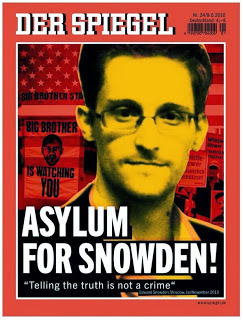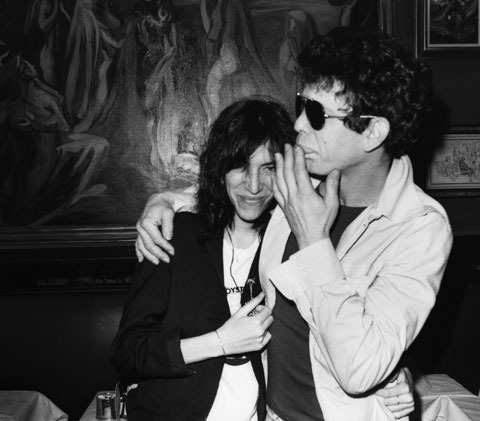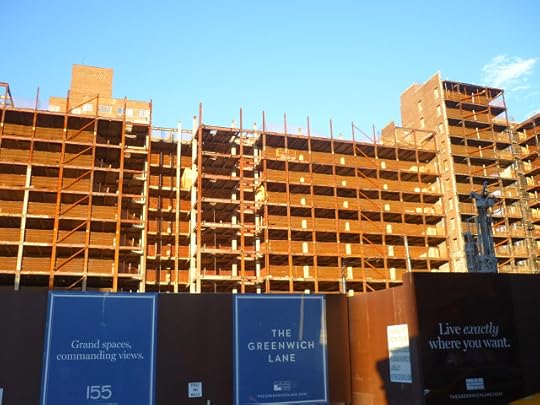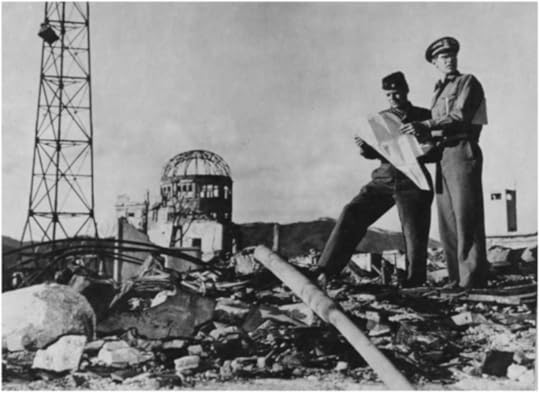Greg Mitchell's Blog, page 183
November 4, 2013
Snowden and the Latest Media Hype
 My new piece at The Nation: "Media Shoot Down Snowden Request for Clemency--But Did He Even Ask for It?"
My new piece at The Nation: "Media Shoot Down Snowden Request for Clemency--But Did He Even Ask for It?"
Published on November 04, 2013 05:42
Patti Says Goodbye to Lou
 Patti Smith says goodbye to Lou Reed (two writers I edited at Crawdaddy) in the pages of The New Yorker--surely an impossible venue for them back when she first saw him play in the summer of 1970 (the exact same time I did). "I didn’t understand his erratic behavior or the intensity of his moods, which shifted, like his speech patterns, from speedy to laconic. But I understood his devotion to poetry and the transporting quality of his performances. He had black eyes, black T-shirt, pale skin. He was curious, sometimes suspicious, a voracious reader, and a sonic explorer."
Patti Smith says goodbye to Lou Reed (two writers I edited at Crawdaddy) in the pages of The New Yorker--surely an impossible venue for them back when she first saw him play in the summer of 1970 (the exact same time I did). "I didn’t understand his erratic behavior or the intensity of his moods, which shifted, like his speech patterns, from speedy to laconic. But I understood his devotion to poetry and the transporting quality of his performances. He had black eyes, black T-shirt, pale skin. He was curious, sometimes suspicious, a voracious reader, and a sonic explorer."
Published on November 04, 2013 04:20
November 3, 2013
Hospital (Don't) Care
What's left of historic St. Vincent's Hospital in Greenwich Village, where my son was born in one of those rooms, still needed but now being torn down to make just what we don't need, luxury condos.


Published on November 03, 2013 20:36
Rodney and Emmy
I saw old friends and bandmates Rodney Crowell and Emmylou Harris across the river at Caramoor last summer and they appeared on Austin City Limits last night (probably showing on local stations different nights around USA). Here are two songs that got cut from show:
Published on November 03, 2013 17:52
Logan's Bad Run
More troubles for that disturbing "60 Minutes" report on Benghazi tragedy last week, which has been picked apart all week for good reason--its star told a totally different story in his official report. Media Matters has been all over it--but now relate criticism from media heavyweights and ethicists. Lara Logan may deserve to get canned, following the Dan Rather example. Totally bogus to not even mention that he told different story earlier. And later asked to be paid for info. And is flacking book. And admits he lied in his initial, so he has a track record.
Marvin Kalb, former host of Meet the Press, past NBC News chief diplomatic correspondent and one-time Moscow bureau chief, called the situation "a serious problem" for 60 Minutes noting Davies "could not both be there, and not be there, at the same time. It is, to put it mildly, surprising that 60 Minutes did not check this discrepancy before broadcast."CNN's Reliable Sources also covered this morning. Can't confirm but someone tweeted to me that "60 Minutes" tonight in their mailbag segment mentioned three positive letters and made no mention of criticism of their report.
Published on November 03, 2013 12:02
Sunday Morning
One of Lou Reed's greatest performances of the song.
Published on November 03, 2013 06:12
November 2, 2013
'NYT' and 'Guardian' With Latest NSA Scoops
Major pieces posted this afternoon by the Times and
The Guardian
(with the latter passing Snowden docs to the former). Massive articles but also note this in Scott Shane's piece: "At the agency’s request, The Times is withholding some details that officials said could compromise intelligence operations."
Published on November 02, 2013 10:35
Rosanne and Others on Lou
At that great Talk House site a collection of fresh comments on Lou Reed's passing, from Courtenay Love to Michael Stipe. Here's Rosanne Cash:
I was a bit in awe of Lou because of Magic and Loss. I thought that record was the most beautiful musical meditation on death I'd heard. I went to see him at Radio City when it came out, and he performed the album in sequence. I wept. It was spectacular. We met doing a radio show together in the early '90s, and not long afterwards I ran into him backstage at the Bob Dylan 30th anniversary show at Madison Square Garden. Neither of us was married at the time, and he asked for my phone number. I think we both realized at the moment he asked that even a single date would have been a disaster. We were so, so different. I shrugged, and we laughed. I worked with him a few times after that — a songwriters-in-the-round show, radio shows, a festival in Brooklyn — and saw him at various events in the city over the years. He was always so sweet to me. He couldn't have been more of a gentleman. I saw the other, difficult side of him in glimpses, but he just seemed like a really sensitive guy who hated pretension and who found it intolerable to compromise on anything that was important to him, whether it was the sound of his monitors or the meal he had ordered. I'll always respect him. Magic and Loss, indeed.
Published on November 02, 2013 08:23
LAX Shooter and New World Order
Details dribbled out yesterday about the L.A. Airport shooter, age 23, and writings he had vaguely described as "anti-government." This CNN update today adds a little, that some of this referred to the nutty New World Order. Which it describes this way: "It's not clear what gave rise to the references, and federal investigators have found no known links to known groups or anything in the suspect's background to explain them. The New World Order is generally considered to be a conspiracy theory in which people suspect a group of elites are conspiring to form an authoritarian, one-world government."
Published on November 02, 2013 06:55
Newsreel Footage on A-Bomb Aftermath Seized by U.S. 68 Years Ago Today
 In the weeks following the atomic attacks on Japan in 1945, and then for decades afterward, the United States engaged in airtight suppression of all film shot in Hiroshima and Nagasaki after the bombings. This included footage shot by U.S. military crews and Japanese newsreel teams. In addition, for many years, all but a handful of newspaper photographs were seized or prohibited not only in the United States, but also in occupied Japan.
In the weeks following the atomic attacks on Japan in 1945, and then for decades afterward, the United States engaged in airtight suppression of all film shot in Hiroshima and Nagasaki after the bombings. This included footage shot by U.S. military crews and Japanese newsreel teams. In addition, for many years, all but a handful of newspaper photographs were seized or prohibited not only in the United States, but also in occupied Japan.Meanwhile, the American public only got to see the same black and white images: a mushroom cloud, battered buildings, a devastated landscape. The true human costs–a full airing of the bomb’s effects on people –were kept hidden. The writer Mary McCarthy declared that Hiroshima had already fallen into “a hole in history.” The public did not see any of the newsreel footage for 25 years, and the U.S. military film remained hidden for more than three decades. (The story is told in full in my book Atomic Cover-up.)
In fact, the Japanese footage might have disappeared forever if the newsreel team had not hidden one print from the Americans in a ceiling. The color U.S. military footage was not shown anywhere until the early 1980s, and has never been fully aired. It rests today at the National Archives in College Park, Md. When that footage finally emerged, I spoke with and corresponded with the man at the center of this drama: Lt. Col. (Ret.) Daniel A. McGovern, who directed the U.S. military film-makers in 1945-1946, managed the Japanese footage, and then kept watch on all of the top-secret material for decades.
McGovern observed that, "The main reason it was classified was...because of the horror, the devastation." I also met and interviewed one top member of his military crew, who had fought for years to get the footage aired widely in America, and interviewed some of the hibakusha who appear in the footage. Those accounts form the center of Atomic Cover-Up . You can read about that a view some of the color footage here. But let's focus on tjhe Japanese newsreel footage for the moment.
On August 6, 1945, the United States dropped an atomic bomb over the center of Hiroshima, killing at least 70,000 civilians instantly and perhaps 70,000 more in the months to follow. Three days later, it exploded another atomic bomb over Nagasaki, killing 40,000 immediately and dooming tens of thousands of others. Within days, Japan had surrendered, and the U.S. readied plans to occupy the defeated country -- and documenting the first atomic catastrophe. But the Japanese also wanted to study it.
Within days of the second atomic attack, officials at the Tokyo-based newsreel company Nippon Eigasha discussed shooting film in the two stricken cities. In early September, just after the Japanese surrender, and as the American occupation began, director Ito Sueo set off for Nagasaki. There his crew filmed the utter destruction near ground zero and scenes in hospitals of the badly burned and those suffering from the lingering effects of radiation. On Sept. 15, another crew headed for Hiroshima.
When the first rushes came back to Tokyo, Iwasaki Akira, the chief producer (and well-known film writer), felt "every frame burned into my brain," he later said. At this point, the American public knew little about human conditions and radiation effects in the atomic cities. Newspaper photographs of victims were non-existent, or censored. Life magazine would later observe that for years "the world...knew only the physical facts of atomic destruction."
On October 24, 1945, a Japanese cameraman in Nagasaki was ordered to stop shooting by an American military policeman. His film, and then the rest of the 26,000 feet of Nippon Eisasha footage, was confiscated by the U.S. General Headquarters (GHQ). An order soon arrived banning all further filming. At this point Lt. Daniel McGovern took charge.
In early September 1945, McGovern had become one of the first Americans to arrive in Hiroshima and Nagasaki. He was a director with the U.S. Strategic Bombing Survey, organized by the Army the previous November to study the effects of the air campaign against Germany, and now Japan.
As he made plans to shoot the official American record, McGovern learned about the seizure of the Japanese footage. He felt it would be a waste to not take advantage of the newsreel footage, noting in a letter to his superiors that "the conditions under which it was taken will not be duplicated, until another atomic bomb is released under combat conditions." McGovern proposed hiring some of the Japanese crew to shoot more footage and edit and "caption" the material, so it would have "scientific value."
About the same time, McGovern was ordered by General Douglas MacArthur on January 1, 1946 to document the results of the U.S. air campaign in more than 20 Japanese cities. His crew would shoot exclusively in color film, Kodachrome and Technicolor, rarely used at the time even in Hollywood.
While all this was going on, the Japanese newsreel team was completing its work of editing and labeling their black and white footage into a rough cut of just under three hours. At this point, several members of the Japanese team took the courageous step of ordering from the lab a duplicate of the footage they had shot before the Americans took over the project. Director Ito later said: "The four of us agreed to be ready for 10 years of hard labor in case of being discovered." One incomplete, silent print would reside in a ceiling until the Occupation ended in 1952.
The negative of the finished Japanese film, nearly 15,000 feet of footage on 19 reels, was sent off to the U.S. in early May 1946. The Japanese were also ordered to include in this shipment all photographs and related material. The footage would be labeled SECRET and not emerge from the shadows for more than 20 years.
During this period, McGovern was looking after both the Japanese and the American footage. Fearful that the Japanese film might get lost forever in the military/government bureaucracy, he secretly made a 16 mm print and deposited it in the U.S. Air Force Central Film Depository at Wright-Patterson. There it remained out of sight, and generally out of mind. On Sept. 12, 1967, the Air Force transferred the Japanese footage to the National Archives Audio Visual Branch in Washington, with the film "not to be released without approval of DOD (Department of Defense)."
Then, one morning in the summer of 1968, Erik Barnouw, author of landmark histories of film and broadcasting, opened his mail to discover a clipping from a Tokyo newspaper sent by a friend. It indicated that the U.S. had finally shipped to Japan a copy of black and white newsreel footage shot in Hiroshima and Nagasaki. The Japanese had negotiated with the State Department for its return. From the Pentagon, Barnouw learned that the original nitrate film had been quietly turned over to the National Archives and went to take a look.
Soon Barnouw realized that, despite its marginal film quality, "enough of the footage was unforgettable in its implications, and historic in its importance, to warrant duplicating all of it," he later wrote. Attempting to create a subtle, quiet, even poetic, black and white film, he and his associates cut it from 160 to 16 minutes, with a montage of human effects clustered near the end for impact.
Barnouw arranged a screening at the Museum of Modern Art in New York, and invited the press. A throng turned out and sat in respectful silence at its finish. "Hiroshima-Nagasaki 1945" proved to be a sketchy but quite moving document of the aftermath of the bombing, captured in grainy but often startling black and white images: shadows of objects or people burned into walls, ruins of schools, miles of razed landscape viewed from the roof of a building.
In the weeks ahead, however, none of the (then) three TV networks expressed interest in airing it. "Only NBC thought it might use the film," Barnouw later wrote, "if it could find a 'news hook.' We dared not speculate what kind of event this might call for." But then an article appeared in Parade magazine, and an editorial in the Boston Globe blasted the networks, saying that everyone in the country should see this film: "Television has brought the sight of war into America's sitting rooms from Vietnam. Surely it can find 16 minutes of prime time to show Americans what the first A-bombs, puny by today's weapons, did to people and property 25 years ago."
This at last pushed public television into the void. What was then called National Educational Television (NET) agreed to show the documentary on August 3, 1970, to coincide with the 25th anniversary of dropping the bomb. "I feel that classifying all of this filmed material was a misuse of the secrecy system since none of it had any military or national security aspect at all," Barnouw told me. "The reason must have been -- that if the public had seen it and Congressmen had seen it -- it would have been much harder to appropriate money for more bombs."
The Barnouw film first (below), then my trailer for my book on the color U.S. footage.
Published on November 02, 2013 04:30



